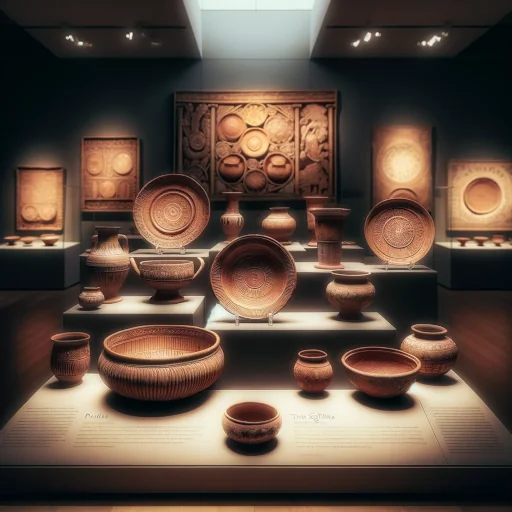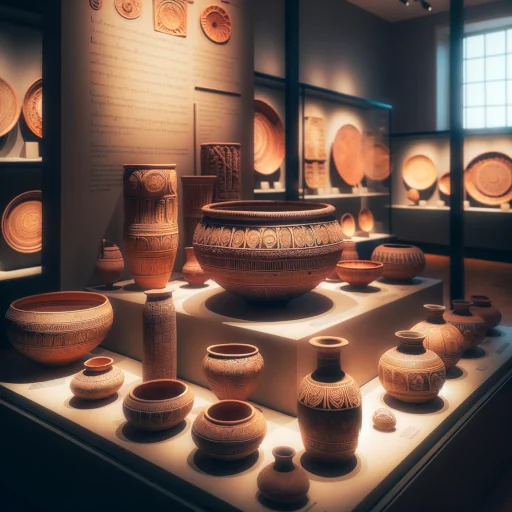Terra Sigillata is an ancient ceramic technique producing a distinctive smooth, high-gloss finish. Originating from Greek and Roman pottery, it involves refining clay to create a fine slip, which is then applied to ceramics. This method enhances the natural clay texture, adding a lustrous sheen to the surface.
In my past writings, I’ve embarked on an explorative journey through the realms of terra sigillata and terracotta. For those who’ve followed along, you might recall our venture into the magic of fine clay slip and its many uses in ceramics, where we unpacked the allure and versatility of terra sigillata. And who could forget our deep dive into the beauty of terracotta, exploring its earthy charm and historical significance?
As we turn a new page, our focus sharpens on terra sigillata, aiming to delve beyond the surface into its intricate crafting process and artistic applications. We’re not just revisiting old grounds; we’re tunneling deeper, unearthing new insights and perspectives. Join me as we explore the nuanced world of terra sigillata, where each brushstroke and firing technique opens a window to a rich legacy of ceramic art. Let’s discover together the continued relevance and innovation this ancient practice brings to the modern art scene.
Historical Context and Archaeological Significance

Terra sigillata’s story is a tapestry woven through time, deeply embedded in the ancient world’s artistic and cultural fabric. Originally emerging in the classical Greek era, it became a hallmark of Roman pottery, known for its fine, glossy finish and intricate stamped designs. This technique, while quintessentially Roman, was not confined to Italy. It spread its roots across the Roman Empire, adapting to regional styles and resources, from the bright red wares of Gaul (modern-day France) to the earthier tones found in North African pieces.
Beyond the Roman realm, the influence of terra sigillata reached far and wide. Its methodology inspired similar approaches in other ancient cultures, each adding their unique flair to this fine art. In the East, for example, variations of terra sigillata emerged, reflecting local artistic sensibilities and clay compositions.
Fast forward to contemporary times, terra sigillata experiences a renaissance in modern ceramic art. Artists are drawn to its historical richness and the unique finish it imparts, integrating ancient techniques with modern designs. This revival not only pays homage to the past but also keeps the tradition alive, continuously evolving and influencing new generations of artists.
The Science of Crafting Terra Sigillata

Crafting terra sigillata is as much a science as it is an art. It involves a delicate balance of chemistry and physics to achieve that signature sheen. The key player in this process is the deflocculant, a chemical that alters the electrical charges of clay particles, causing finer particles to remain suspended in water. This separation is crucial for creating the ultra-fine slip that defines terra sigillata.
The process is a meticulous one, governed by specific gravity, a measure of the density of the slip compared to water. This metric is pivotal in determining the right consistency of the slip, which should be neither too thick nor too thin for application.
Artisans experiment with different clay types and deflocculant ratios, fine-tuning their recipes through trial and error. The variability in clays – their particle size, mineral content, and even regional characteristics – add layers of complexity to the process. Each batch of terra sigillata is a testament to the artisan’s understanding of these subtleties, reflecting their skill and dedication to the craft.
Advanced Techniques and Artistic Applications
The realm of contemporary ceramic art, especially where terra sigillata is concerned, is a vibrant playground of innovation and experimentation. Let’s delve into the intricate world of advanced terra sigillata techniques, as practiced by some of today’s most forward-thinking artists.
Rhonda Willers: Exploring Materiality and Firing Techniques
Rhonda Willers, renowned for her work with terra sigillata, emphasizes the versatility of this medium. In her approach, the focus lies on exploiting the full potential of terra sigillata across various temperatures and clay types. This expands the perceived limitations of terra sigillata, traditionally associated with low-fire earthenware, to include high-temperature firings and diverse clay bodies.1
Advanced Application Methods
- Brushing, Dipping, and Spraying: These techniques are fundamental in applying terra sigillata, but the mastery lies in their nuanced execution. Brushing can retain brush marks, adding texture, while dipping offers a more uniform coat. Spraying allows for gradient layers and multi-layered effects. Each method requires careful consideration of the medium’s properties and the desired outcome.
- Layering and Texture: Advanced practitioners often layer different colors of terra sigillata, creating complex surfaces that interact with light and shadow uniquely. Textural effects are achieved through carving or sgraffito, revealing underlying layers or contrasting colors.
In Large-Scale Installations
In the hands of contemporary artists, terra sigillata becomes a medium for large-scale artistic expression. Its ability to convey both fragility and strength makes it ideal for installations that explore themes of memory, nature, and the human experience. This approach often involves repetitive forms and markings, creating a dialogue between the material and the concept.
Terra sigillata’s evolution in the hands of contemporary artists showcases its enduring appeal and adaptability. It’s not just a medium with a storied past but a vibrant, dynamic tool for artistic expression, constantly being reshaped and redefined by the hands and minds of skilled artisans.
Linking Terra Sigillata with Terracotta
Let’s weave together the stories of terra sigillata and terracotta, two distinct yet interconnected realms of the ceramic world. Despite their shared clay foundation, they diverge in usage and aesthetic, each with its own unique charm.
Complementary Contrasts
- Aesthetic Diversity: Terra sigillata, known for its fine, glossy finish, offers a stark contrast to terracotta’s earthy, unglazed texture. This juxtaposition can be artistically leveraged.
- Enhancing Techniques: Applying terra sigillata on terracotta pieces can elevate their visual appeal, adding a lustrous sheen that highlights the natural reddish-brown hues of terracotta.
Artistic Synergy
- For a deeper understanding of the technical aspects of making, mixing, and applying terra sigillata, Rhonda Willers’ 2019 book, “Terra Sigillata: Contemporary Techniques,” is an invaluable resource. In it, Willers delves into the nuances of working with terra sigillata, both as a standalone medium and in combination with other materials. Her insights are particularly useful for those interested in exploring innovative applications and techniques, offering a blend of traditional methods and modern artistic approaches. This book is a must-read for anyone looking to deepen their knowledge and skills in the world of contemporary ceramic art.2
- In Lynn Peters’ 2001 book, “Surface Decoration for Low-Fire Ceramics,” there’s a rich exploration of various techniques for decorating ceramics, specifically focusing on low-temperature firings. The book covers a wide array of methods including the use of slips, terra sigillata, underglazes, glazes, and more, to achieve vibrant, colorful surfaces. This comprehensive guide is particularly insightful for those looking to blend functional and decorative elements in their ceramic work, offering a multitude of ways to enhance the aesthetic appeal of low-fired ceramics while maintaining their practicality.3
In essence, terra sigillata and terracotta, while distinct, can be harmoniously intertwined, enhancing and complementing each other in both form and function.
The Future of Terra Sigillata in Ceramic Arts
Peering into the future of terra sigillata, we stand at the brink of endless possibilities. This ancient medium, steeped in history, is ripe for innovation and experimentation in the modern ceramic arts landscape.
Innovations on the Horizon
- Technological Integration: Imagine terra sigillata combined with digital printing techniques or 3D sculpting. The fusion of old and new could redefine the boundaries of ceramic art.
- Sustainable Practices: As we become more environmentally conscious, expect to see terra sigillata used in ways that prioritize sustainability, perhaps with natural, locally-sourced materials.
A Call to Experiment
- Community Engagement: I encourage you, fellow artists and enthusiasts, to play with terra sigillata, to push its limits. Share your triumphs and challenges. It’s through this shared journey that we’ll unearth new paths and techniques.
- Ongoing Learning: Stay curious, stay innovative. The future of terra sigillata is not just in the hands of the experts but in the community’s collective imagination and creativity.
The future of terra sigillata is unwritten, and it’s up to us, the ceramic artists and enthusiasts, to chart its course. Let’s make it a vibrant, ever-evolving journey!
Interactive Q&A
FAQ
What is the best clay for Terra Sigillata?
The best clay for terra sigillata often depends on the desired finish and firing temperature. Ball clay and kaolin are popular choices due to their fine particle size, which is ideal for creating a smooth, polished surface.
Who was the artist who worked with clay?
Historically, numerous artists have worked with clay. One renowned figure is Marguerite Wildenhain, a Bauhaus-trained potter known for her exceptional work in ceramic arts.
Can you glaze over Terra Sigillata?
Yes, you can glaze over terra sigillata, but it requires careful consideration of the glaze’s firing temperature and compatibility with the underlying slip to prevent issues like cracking or peeling.
How do you add color to Terra Sigillata?
Color can be added to terra sigillata by incorporating ceramic stains or oxides into the slip mixture. This method allows for a range of hues while maintaining the signature smooth and shiny finish of terra sigillata.
Footnotes
- https://thepotterscast.com/533 ↩︎
- Willers, Rhonda. Terra Sigillata: Contemporary Techniques. United States: American Ceramic Society, 2019. ↩︎
- Peters, Lynn. Surface Decoration for Low-fire Ceramics: Slips, Terra Sigillata, Underglazes, Glazes, Maiolica, Overglaze Enamels, Decals. United States: Lark Books, 2001. ↩︎





